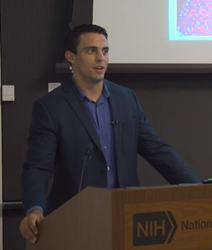
We recognize that for every assay there is a delicate balance between data density (i.e. images per model) and throughput
WHITEHOUSE STATION, N.J. (PRWEB)
September 09, 2019
Visikol CEO Dr. Michael Johnson recently gave a talk at the National Institute of Health that was focused on how best to characterize 3D cell culture models. The inherent problem of characterizing 3D cell culture models is similar to regular tissues in that they are too thick and opaque to image through and therefore traditional wide-field or even confocal microscopy only tells you what is going on at the surface of these models. Because the surface cells are most exposed to compounds, nutrients, and oxygen, using this imaging data to extrapolate results can be very misleading as it only tells the story of the cells on the exterior and not the entire cell population. This bias has been detailed by Visikol through a recent application note titled 3D High Content Imaging of Optically-Cleared Microtissues for Screening Antiproliferative Cancer Drugs.
While 3D cell culture models could be embedded and sectioned for H&E and IHC, this process is laborious, low throughput and also greatly reduces an experiments sample size as many 3D cell culture models need to be embedded to acquire a single section from a single model. Additionally, based upon the polarity of a 3D cell culture model, this single slice might not be indicative of the phenotype of interest. Therefore, in this presentation Dr. Johnson goes into great detail on how to use tissue clearing to image the entirety of 3D cell culture models in multiple imaging channels without the need to ever section or remove the models from a well plate. Though this type of processing and confocal microscopy can reduce sample throughput compared to traditional wide-field imaging, it greatly increases the amount of data that can be generated per model, improves the accuracy of the conclusions that are made and also allows for the investigation of complex research questions.
“We see our Visikol® HISTO-M™ workflow as an easy-to-use pipeline for acquiring all of the information from 3D cell culture models but do recognize that for every assay there is a delicate balance between data density (i.e. images per model) and throughput,” described Dr. Johnson. Visikol currently sells the Visikol HISTO-M reagent and also offers end-to-end drug discovery services that leverage this technology combined with Visikol’s expertise in 3D cell culture, imaging and image analysis. Specifically, Visikol offers best-in-class 3D cell culture assays using this platform to address questions such as quantifying immune cell infiltration or assessing antibody therapeutic kinetics. If you are interested in discussing a 3D cell culture project or transitioning your 2D cell culture assay into a 3D cell culture assay reach out today.
About Visikol
Visikol is a CRO focused on advanced drug discovery that is leading the fields of bio-imaging, bioinformatics and image analysis. We conduct end-to-end drug discovery services that include both 2D and 3D in vitro models and assays, 3D whole mount tissue imaging, digital pathology and custom drug discovery projects. Visikol offers a portfolio of drug discovery services ranging from 2D and 3D cell culture model and assay development to in vitro screening, animal tissue histology and automated image processing. The focus of these services is to transform tissues into images and ultimately into quantitative data sets that can be mined for actionable insights that help our Clients make more informed decisions during the drug discovery process. Additionally, Visikol manufactures and sells a suite of tissue clearing reagents and 3D immuno-labeling kits. These products allow researchers to easily and rapidly image whole tissues and 3D cell culture models in 3D instead of traditional 2D sectioning. For more information about Visikol or its services, please visit our website at visikol.com.
Share article on social media or email:
